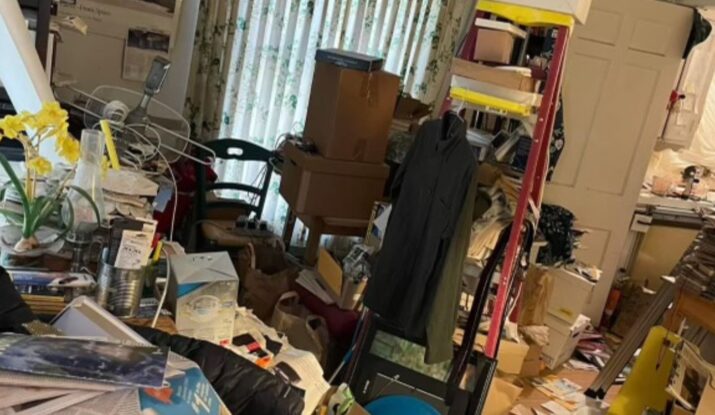Are you facing the daunting task of cleaning up a hoarder’s living space? Hoarding can present significant health and safety concerns, but with the right strategies in place, you can tackle the situation effectively and ensure the well-being of everyone involved. In this article, we will explore ten proven methods for addressing health and safety issues during hoarder cleanup. From creating a comprehensive plan to implementing proper personal protective equipment, these strategies will empower you to navigate this challenging task with confidence.
Understanding the Risks in Hoarder Cleanup
Hoarder cleanup is a challenging task that requires careful consideration of the potential risks involved. To effectively address health and safety issues, it is important to first assess the type of hoard and identify potential hazards. This will allow you to analyze the risk of infectious diseases and understand any structural hazards that may be present.
Assessing the type of hoard
The first step in addressing health and safety issues in hoarder cleanup is to assess the type of hoard. Different hoards may present varying levels of risk. For example, a hoard primarily consisting of paper and other non-hazardous materials will pose different challenges compared to a hoard contaminated with mold or animal waste. By understanding the nature of the hoard, you can better prepare for the cleanup process and ensure appropriate safety measures are in place.
Identifying potential hazards
When dealing with hoarder cleanup, it is essential to identify and address potential hazards. These hazards can range from structural issues, such as unstable piles of belongings, to biohazards like mold, pests, and bacteria. By carefully inspecting the hoard and assessing the environment, you can determine the specific hazards present and develop a plan to mitigate them.
Analyze risk of infectious diseases
One of the major health risks in hoarder cleanup is the potential for exposure to infectious diseases. In a hoarding environment, mold, bacteria, and pests can flourish, creating an unhealthy living space. It is crucial to analyze the risk of infectious diseases and take appropriate measures to minimize exposure. This may involve wearing personal protective equipment (PPE), implementing thorough cleaning and disinfection protocols, and considering the need for professional assistance.
Understanding structural hazards
In addition to the health risks, hoarder cleanup may also involve addressing structural hazards. Accumulated belongings and debris can put a significant strain on the structure of a home, potentially compromising its stability. It is important to assess the structural integrity of the hoarding site and take steps to ensure the safety of both the cleanup crew and the hoarder. This may include reinforcing weakened structures, removing heavy items, or consulting with a professional for expert guidance.
Developing a Cleaning Plan
Once the risks have been assessed, it is crucial to develop a comprehensive cleaning plan. This plan should outline the scope of work, establish a timeline for completion, allocate necessary resources, and identify the most appropriate disposal method.
Determining the scope of work
Before beginning the cleanup process, it is important to determine the scope of work. This involves identifying the specific areas that require attention and understanding the extent of the cleanup required. By clearly defining the scope, you can better allocate resources and ensure that all necessary tasks are addressed.
Establishing a timeline
Cleaning up a hoard can be a time-consuming process, so it is essential to establish a realistic timeline for completion. This timeline should take into account the size of the hoard, the complexity of the cleanup, and any potential challenges that may arise. By setting achievable milestones and regularly reviewing progress, you can stay on track and ensure that the cleanup process is completed within the planned timeframe.
Allocating resources
Hoarder cleanup often requires a team effort and the allocation of appropriate resources. This includes determining the number of workers needed, acquiring necessary cleaning supplies and equipment, and considering any additional support that may be required, such as waste management services. By properly allocating resources, you can ensure that the cleanup process is efficient and effective.
Identifying the disposal method to be used
Proper disposal of hoarded items is a critical aspect of the cleanup process. It is important to identify the most appropriate disposal method based on the type of hoard and any regulatory requirements. This may include arranging for waste removal services, coordinating donations or recycling efforts, or following specific guidelines for hazardous materials. By carefully considering the disposal method, you can minimize environmental impact and ensure compliance with relevant regulations.

Safety Measures in Hoarder Cleanup
In order to ensure the health and safety of everyone involved in the hoarder cleanup process, it is crucial to implement a range of safety measures. These measures should cover personal protective equipment, precautions against sharp objects, prevention of exposure to biohazards, and structural safety.
Ensuring appropriate personal protective equipment is used
Personal protective equipment (PPE) is essential in hoarder cleanup to protect workers from potential health hazards. This may include items such as gloves, masks, goggles, and protective clothing. It is essential to ensure that all workers have access to and properly use the necessary PPE throughout the entire cleanup process.
Precautions against sharp objects
Hoarder environments often contain sharp objects, such as broken glass or metal. It is important to take precautions against these hazards to prevent injuries. This may involve wearing sturdy footwear, using tools specifically designed for handling sharp objects, or creating designated disposal areas for such items. By implementing these precautions, the risk of cuts or puncture wounds can be minimized.
Preventing exposure to biohazards
Biohazards, including mold, bacteria, and animal waste, are commonly found in hoarded environments. To prevent exposure to these hazards, it is crucial to implement proper cleaning and disinfection protocols. This may involve using appropriate cleaning agents, following recommended procedures for decontamination, and properly disposing of biohazardous waste. By taking these measures, the risk of developing health issues due to exposure can be significantly reduced.
Structural safety measures
Considering the potential structural hazards present in a hoarded environment, it is important to prioritize and address any safety concerns. This may involve reinforcing weakened structures, temporarily bracing or removing heavy items, or consulting with a structural engineer for professional guidance. By ensuring structural safety, the risk of accidents or collapses during the cleanup process can be minimized.
Involving the hoarder in the Cleanup Process
In hoarder cleanup, involving the hoarder in the process can be a valuable approach to address both the physical and psychological aspects of hoarding disorder. Communicating with the hoarder, encouraging their involvement, and teaching them disposal decision-making skills are key steps in this process.
Communicating with the hoarder
Open and respectful communication with the hoarder is essential for a successful cleanup process. It is important to understand their perspective, concerns, and attachment to their belongings. By actively listening and addressing their needs, you can build trust and foster a cooperative working relationship.
Encouraging the hoarder’s involvement
Empowering the hoarder to actively participate in the cleanup process can have significant benefits. This involvement allows them to regain a sense of control over their living environment and fosters ownership of the decision-making process. Encourage the hoarder to make choices regarding item disposal or organization methods, while providing guidance and support along the way.
Teaching the hoarder disposal decision-making skills
A crucial aspect of involving the hoarder in the cleanup process is teaching them disposal decision-making skills. This involves helping them differentiate between items of value and those that can be safely discarded. By providing education and guidance on decluttering strategies, the hoarder can develop skills to maintain a clutter-free and organized living space in the long term.

Handling of Personal Belongings
Respecting the hoarder’s possessions and ensuring their proper handling are important aspects of the cleanup process. Cataloguing belongings, considering donation or recycling methods, and implementing respectful practices can make a significant difference.
Cataloguing belongings
Before beginning the cleanup process, it is important to catalogue the hoarder’s belongings. This involves creating a detailed inventory of the items present, categorizing them, and documenting their condition. Cataloguing not only assists in organizing the cleanup efforts but also ensures that important or sentimental possessions are not inadvertently lost during the process.
Respecting the hoarder’s possession
During the cleanup, it is crucial to respect the hoarder’s possessions and belongings. Understand that their attachment to items may be emotional and that parting with them can be challenging. Handle their possessions with care and empathy, ensuring that items of sentimental value or importance are preserved and protected throughout the cleanup process.
Donation and recycling methods
Consideration should be given to donation and recycling methods for items that the hoarder chooses to part with during the cleanup. Identify local charities or organizations that accept donations and arrange for their collection. Additionally, research recycling options for items that cannot be donated, ensuring that the cleanup process has a minimal impact on the environment.
Psychological Considerations during Cleanup
Hoarding disorder is a complex mental health condition, and addressing psychological considerations during cleanup is crucial. Understanding hoarding disorder, showing empathy and respect, and effectively managing potential hostility or resistance are key aspects to consider.
Understanding hoarding disorder
To effectively address the psychological aspects of hoarding, it is important to have a basic understanding of hoarding disorder. Educate yourself on the condition, its possible causes, and its impact on the individual’s life. This knowledge will help you approach the cleanup process with empathy and understanding.
Showing empathy and respect
When working with individuals affected by hoarding disorder, it is essential to show empathy and respect. Understand that the hoarder may have developed emotional attachments to their belongings and that parting with them can be extremely difficult. Approach the cleanup process with patience, compassion, and a non-judgmental attitude to create a safe and supportive environment.
Dealing with potential hostility or resistance
Hoarding cleanup can evoke strong emotions in the hoarder, leading to potential hostility or resistance. It is important to anticipate and effectively manage these reactions. Maintain open lines of communication, provide reassurance, and actively involve the hoarder in decision-making processes to help address any concerns or fears. If necessary, seek guidance from mental health professionals experienced in hoarding disorder.

Post-Cleanup Support
Providing post-cleanup support is essential to ensure that the hoarder maintains a clutter-free and organized living space. Implementing maintenance strategies, assisting in the implementation of organization systems, and referring to professional help if necessary are important steps in this phase.
Maintenance strategies
Support the hoarder in maintaining a clutter-free and organized living space by implementing effective maintenance strategies. This may include regular cleaning schedules, organization techniques, and practicing habits that prevent the re-accumulation of clutter. By providing ongoing guidance and support, you can help the hoarder maintain the progress made during the cleanup process.
Assistance in implementing organization systems
Help the hoarder implement organization systems that are tailored to their needs and preferences. This may involve organizing belongings into designated categories, labeling storage spaces, and providing guidance on effective organization techniques. By assisting in the implementation of organization systems, the hoarder can better manage their possessions and maintain a more functional living space.
Referral to professional help if necessary
In some cases, the hoarder may benefit from ongoing support from mental health professionals. If challenges related to hoarding disorder persist or if additional mental health concerns arise during or after the cleanup process, it is important to refer the individual to the appropriate professional help. Qualified therapists or counselors can provide the necessary guidance and support to address the underlying causes of hoarding disorder.
Involving Professionals in Hoarder Cleanup
While some hoarder cleanup projects can be managed independently, there are situations where involving professionals is necessary. Understanding when to involve professionals, the benefits of professional assistance, and choosing the right professional cleanup service are important considerations.
When to involve professionals
Hoarder cleanup projects that involve significant structural hazards, biohazards, or extreme hoarding situations may require the expertise of professional cleanup services. Professional assistance should be considered when the safety of the cleanup crew or the hoarder is at risk, or when specialized equipment and training are needed to address specific challenges.
Benefits of professional assistance
Professional cleanup services bring several benefits to hoarder cleanup projects. These professionals have the expertise, experience, and specialized equipment necessary to address complex health and safety issues. They are trained to handle biohazards, properly dispose of hazardous materials, and navigate challenging cleanup scenarios. In addition, their involvement can help alleviate the emotional burden on the hoarder and their loved ones.
Choosing the right professional cleanup service
When selecting a professional cleanup service for hoarder cleanup, it is important to conduct thorough research and choose a reputable and experienced company. Consider factors such as their certifications, professional affiliations, customer reviews, and the specific services they provide. Request detailed estimates and compare prices and service offerings to ensure that you select a service that aligns with your needs and requirements.
Cleanup during COVID-19 Pandemic
During the COVID-19 pandemic, additional precautions are necessary when conducting hoarder cleanup. Following guidelines and regulations, utilizing remote assessment tools, and implementing extra safety measures are essential steps to ensure the health and safety of everyone involved.
Extra precautions during a pandemic
When conducting hoarder cleanup during a pandemic, it is important to implement additional precautions to prevent the spread of COVID-19. This may include wearing appropriate PPE, practicing frequent hand hygiene, maintaining physical distancing, and following disinfection protocols recommended by health authorities. Stay updated with the latest guidelines from public health agencies to ensure compliance.
Utilizing remote assessment tools
To minimize in-person contact and improve efficiency, consider utilizing remote assessment tools. These tools, such as video calls or virtual inspections, can allow for initial assessments to be conducted remotely, reducing the need for unnecessary travel or physical presence. Remote assessments can provide valuable insights that help determine the scope of work and plan the cleanup process effectively.
Following government regulations and guidelines
During a pandemic, it is crucial to stay informed about government regulations and guidelines related to hoarder cleanup. These regulations may impact the number of people allowed to be present, disposal methods for biohazardous items, or the use of specific cleaning agents. By adhering to these regulations, you can ensure a safe and compliant cleanup process.
Legal Considerations in Hoarder Cleanup
Legal considerations are an important aspect of hoarder cleanup, particularly when dealing with issues such as child or elder neglect, or as a landlord or tenant. Understanding the legal aspects, dealing with legal issues, and being aware of tenants and landlord rights can help navigate potential challenges.
Dealing with legal issues
Hoarder cleanup may involve addressing legal issues, particularly in cases where child or elder neglect is suspected. In such situations, it is important to involve the appropriate authorities, such as child protective services or adult protective services. These agencies are equipped to handle legal matters related to neglect and can provide the necessary support and guidance.
Understanding tenants and landlord rights
In hoarding situations that involve rental properties, it is crucial to understand the rights and responsibilities of both tenants and landlords. Familiarize yourself with local laws and regulations regarding eviction or tenant rights in relation to hoarding. Consult legal professionals to ensure that proper procedures are followed and rights of all parties involved are protected.
Steps in case of child or elder neglect
If hoarder cleanup reveals evidence of child or elder neglect, specific steps need to be taken to ensure the safety and wellbeing of individuals involved. Contact the appropriate authorities, such as child protective services or adult protective services, and follow their guidance. These agencies will conduct investigations and provide the necessary support to address the neglect and ensure the safety of those affected.
In conclusion, addressing health and safety issues in hoarder cleanup requires a comprehensive approach that encompasses understanding the risks, developing a cleaning plan, implementing safety measures, involving the hoarder, handling personal belongings, considering psychological considerations, providing post-cleanup support, involving professionals when needed, addressing legal considerations, and adapting to additional challenges such as the COVID-19 pandemic. By following these strategies and guidelines, you can effectively address health and safety issues in hoarder cleanup and create a safer and more organized living environment for those affected by hoarding disorder.



